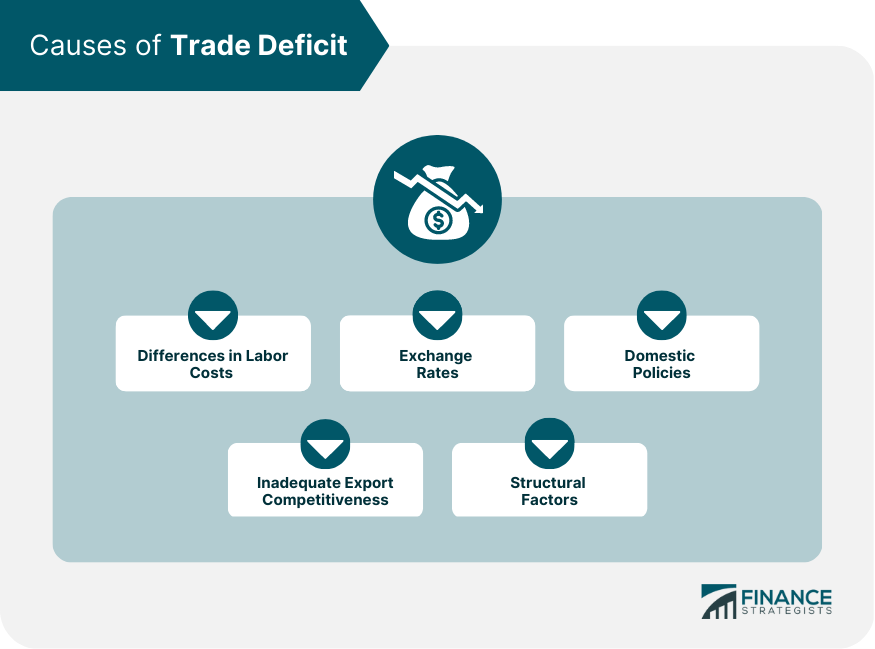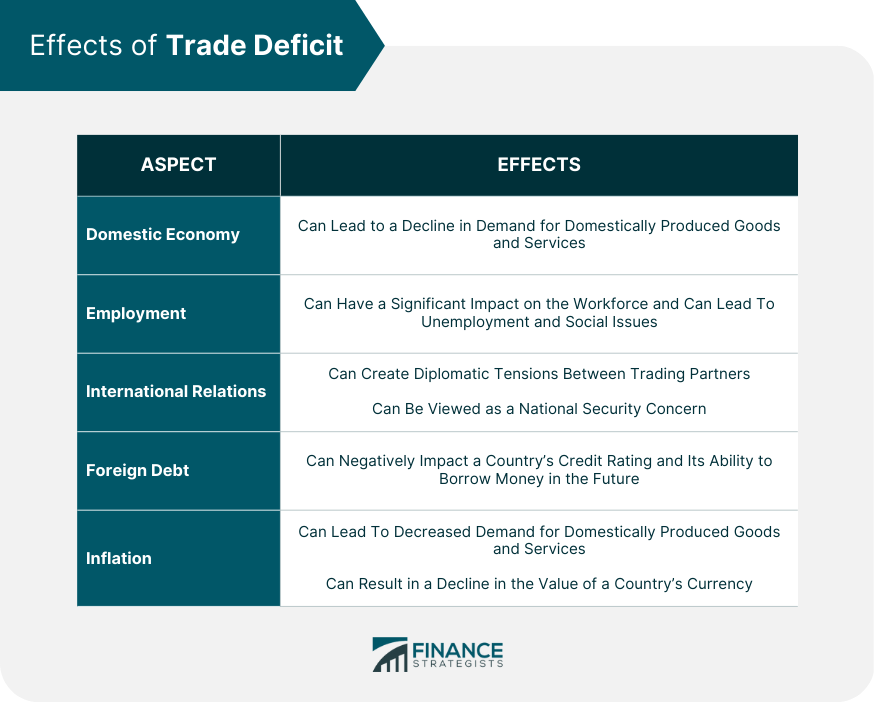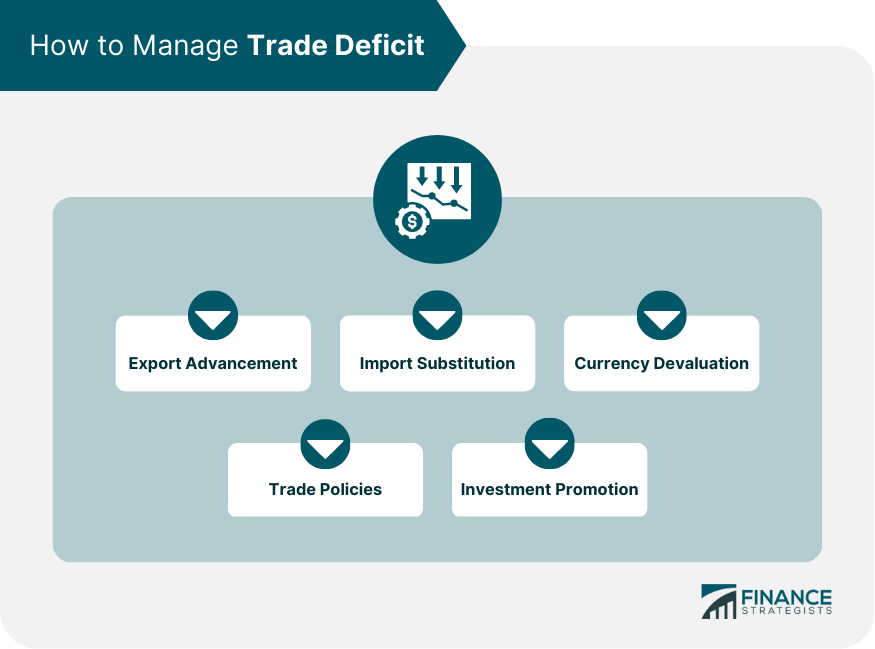Trade deficit is a situation where a country's imports of goods and services exceed its exports of goods and services to other countries. In other words, it occurs when a country's spending on imports is greater than its income from exports. A trade deficit is also known as a negative balance of trade, and it can be a source of concern for governments, policymakers, and economists. Trade deficits can have both positive and negative effects on a country's economy, and they can be caused by a variety of factors, including differences in labor costs, exchange rates, and domestic policies. Several factors contribute to trade deficits. The primary cause is a country's demand for imported goods and services that exceed its exports. The following are some of the factors that contribute to trade deficits: Countries with high labor costs are likely to experience trade deficits, as their exports become more expensive compared to imports. For instance, a country with a high minimum wage rate may find it difficult to compete with other countries where labor is cheaper. As a result, they may import more goods and services than they export, leading to a trade deficit. When a country's currency appreciates against its trading partners' currencies, its exports become more expensive, while imports become cheaper. It can lead to a trade deficit if the country's imports rise above its exports. For example, if the U.S. dollar appreciates against the euro, American products become more expensive to European consumers, while European products become cheaper to American consumers. This situation can lead to a higher demand for European goods in the U.S., resulting in a trade deficit. Policies that boost domestic demand, such as tax cuts, subsidies, and increased government spending, can lead to a rise in imports, which can exacerbate trade deficits. Suppose a government cuts taxes. Consumers may have more disposable income to spend on imported goods and services, leading to a higher demand for imports and a trade deficit. Trade deficits can occur when a country is unable to produce goods and services that are competitive in the global market. As a result, they may need to rely on importing more goods and services than they export, which can contribute to a trade deficit. It is because they may not be able to meet the demand for certain goods and services domestically due to various factors, such as a lack of technological advancement, insufficient investment in research and development, or inefficient production methods. Demographics, natural resource endowments, and the level of economic development can also contribute to trade deficits. For example, a country with an aging population may have a higher demand for imports of goods and services that cater to the needs of the elderly. This situation can result in a trade deficit, as the country may not have the capacity to produce these goods and services domestically. Similarly, a country that lacks natural resources may have to import more than it exports, resulting in a trade deficit. Trade deficits can have both positive and negative effects on a country's economy. Consider the following: Trade deficits can hurt a country's domestic economy. When a country imports more than it exports, there is a decline in demand for domestically produced goods and services. It can result in layoffs, reduced production, and plant closures. The loss of jobs can have a ripple effect on the overall economy, as it can lead to reduced consumer spending and decreased economic growth. Additionally, domestic industries that face import competition may find it difficult to compete with cheaper imported goods, which can lead to lower production levels and economic contraction. Trade deficits can lead to the loss of jobs in industries that face import competition. It happens when imports replace domestic production, leading to declining demand for domestic goods and services. The loss of jobs can have a significant impact on the workforce and can lead to unemployment and social issues. In some cases, job losses can result in a loss of skills and experience, which can be difficult to recover in the future. When a country has a trade deficit, it becomes indebted to its trading partners. It can create diplomatic tensions between trading partners, potentially leading to strained relations and trade conflicts. Trading partners may use a trade deficit as an economic pressure point to force a country to open its markets to their exports. They may implement tariffs or other trade barriers to restrict the country's access to their markets. Trade deficits can also be viewed as a national security concern. This is especially true when a country heavily relies on imports of essential goods, such as food, energy, or technology. In this case, it can be a vulnerability, and it may be used as leverage to gain influence over the country. Trade deficits can lead to the accumulation of foreign debt. It is the result of a country importing more than it exports, and it must borrow money from other countries to finance the deficit. An increase in foreign debt can negatively impact a country's credit rating and its ability to borrow money in the future. High levels of foreign debt can also result in higher interest payments, which can further increase the burden on the economy. Trade deficits can also contribute to a general rise in prices. An upswing in imports can lead to decreased demand for domestically produced goods and services, resulting in lower production levels and higher prices for domestic goods and services. It raises the cost of living for citizens. Additionally, a trade deficit can result in a decline in the value of a country's currency, leading to higher import prices and inflation. Trade deficit and surplus reflect the difference between a country's exports and imports. As discussed above, a trade deficit occurs when a country imports more than it exports. On the other hand, a trade surplus refers to a situation when a country exports more than it imports. A trade deficit can have a negative impact on a country's economy. It is because a trade deficit can lead to a decline in domestic production, job losses, and inflation. In contrast, a trade surplus can boost a country's economy. It can lead to increased domestic production, job creation, and increased foreign investment. When a country exports more than it imports, there is an increase in demand for domestically produced goods and services, which can lead to increased production, job creation, and economic growth. Additionally, a trade surplus can attract foreign investment as investors may see the country as a profitable market for their goods and services. Trade deficits and surpluses can also affect a country's foreign exchange rates. A trade deficit can lead to a decline in a country's currency, while a trade surplus can lead to an increase in its currency. It is because a trade deficit increases the demand for foreign currency, while a trade surplus increases the demand for domestic currency. The change in foreign exchange rates can have a significant impact on a country's economy, as it affects the cost of imports and exports. It is a critical concern for countries to promote sustainable economic growth. A trade deficit can have significant negative impacts on a country's economy. Below are some strategies that countries can use to manage trade deficits: Countries need to identify their competitive advantage and develop policies that support their export industries. It can involve providing incentives to domestic companies to expand their export operations, investing in research and development to promote innovation, and promoting trade agreements that facilitate exports. A focus on export promotion can increase the demand for domestically produced goods and services, creating jobs and boosting economic growth. This strategy involves reducing imports by increasing the domestic production of goods and services that are currently imported. Governments can incentivize domestic companies to produce these goods and services or implement policies that reduce the cost of production. Import substitution can help reduce the demand for imported goods and services, reducing the trade deficit. It is a strategy some countries use to manage a trade deficit. It involves reducing the value of the country's currency relative to other currencies, making exports cheaper and imports more expensive. Currency devaluation can make domestically produced goods and services more competitive in the global market, leading to increased exports and reduced imports. However, this strategy can also lead to inflation, as the cost of imported goods increases. Governments can also implement trade policies, which involve imposing tariffs or other trade barriers on imports to reduce their demand while providing subsidies or other incentives to domestic producers. Trade policies can also revolve around negotiating trade agreements that promote fair trade practices and reduce barriers to entry for domestic producers. However, trade policies can also lead to retaliatory actions by trading partners, potentially leading to trade conflicts. Countries can also promote foreign investment. It can involve providing incentives to foreign businesses and companies to invest in domestic industries. It may also entail promoting special economic zones that offer tax incentives and streamlined regulatory processes and facilitating the transfer of technology and knowledge. Foreign investment can help boost domestic production, create jobs, and increase exports, reducing the trade deficit. A trade deficit is when a country imports more goods and services than it exports. It can be caused by several factors, including differences in labor costs, exchange rates, and domestic policies. Compared to a trade surplus, or when a country exports more than it imports, a trade deficit can negatively impact the economy. It can lead to job losses, inflation, increased foreign debt, and potentially strain foreign relations. Countries can manage trade deficits by promoting exports, reducing imports through import substitution, currency devaluation, implementing trade policies, and promoting foreign investment. Consult a qualified financial advisor or wealth management professional to learn more about trade deficits and how they affect an individual’s financial interests. What Is Trade Deficit?
Causes of Trade Deficit
Differences in Labor Costs
Exchange Rates
Domestic Policies
Inadequate Export Competitiveness
Structural Factors

Effects of Trade Deficit
Domestic Economy
Employment
International Relations
Foreign Debt
Inflation

Trade Deficit vs Trade Surplus
How to Manage Trade Deficit
Export Advancement
Import Substitution
Currency Devaluation
Trade Policies
Investment Promotion

The Bottom Line
Trade Deficit FAQs
A trade deficit occurs when a country imports more goods and services than it exports.
A trade deficit can lead to job losses, reduced domestic production, inflation, increased foreign debt, and strained foreign relations.
Countries can manage trade deficits by promoting exports, reducing imports through import substitution, currency devaluation, implementing trade policies, and promoting foreign investment.
In some cases, a trade deficit can be beneficial if it enables a country to import essential goods and services that are not available domestically or if it allows a country to focus on producing goods and services in which it has a comparative advantage.
A trade deficit can lead to a decline in a country's currency exchange rates as it increases the demand for foreign currency, while a trade surplus can lead to an increase in its currency exchange rates as it increases the demand for domestic currency.
True Tamplin is a published author, public speaker, CEO of UpDigital, and founder of Finance Strategists.
True is a Certified Educator in Personal Finance (CEPF®), author of The Handy Financial Ratios Guide, a member of the Society for Advancing Business Editing and Writing, contributes to his financial education site, Finance Strategists, and has spoken to various financial communities such as the CFA Institute, as well as university students like his Alma mater, Biola University, where he received a bachelor of science in business and data analytics.
To learn more about True, visit his personal website or view his author profiles on Amazon, Nasdaq and Forbes.















